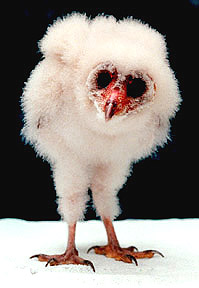|
Volunteer Phil Quintenz wasn't sure what he had in the box. He had been sent to Harvel to pick up two red-tailed hawk chicks made homeless when the tree housing their nest was cut down. They didn't look like hawks to him, and their hiss sounded like a natural gas leak. Phil called The Illinois Raptor Center and described their behavior to Jacques Nuzzo.
"Put the phone in the box so I can hear," Jacques suggested. That distinctive hiss, carried over the cellular phone, told Jacques immediately that Phil was bringing two state endangered barn owl chicks to the center. Barn Owls are extremely rare in Illinois. The opportunity to lend a helping hand to an Illinois endangered species generated a lot of excitement back at the office.
Farmer Ivan Benning felt terrible. He cut the old tree down because he feared it might fall across the road running past his home. As he was dragging the trunk away to be burned, he heard the same unmistakable hiss. His wife, Karen, knew what to do, and was soon in touch with the IRC.
Jacques contacted Glen Kruse, Endangered Species Program Manager at the Ill. Dept. of Natural Resources . Discussion took place on how the chicks would be cared for and how they would eventually be released.
Their arrival created quite a stir in the community. Local television stations and newspapers carried the barn owl story. Their plight was front page news in the Decatur Herald & Review. Again, people in the area were talking about endangered species.
It was decided to give the IRC's two resident barn owls, Zen and Geist their first opportunity to be surrogate parents. Many of our resident birds of prey have taken over parenting duties countless times with great success. (Our American kestrel Gwen has raised dozens of kestrels over the years. ) Once the chicks were ready, they would move into an enclosure (or mew) with their new parents.
At first, things went as planned. The chicks, still in a carrier, were placed in the
|
mew so everyone could get acquainted. Observation told us that the owls seemed to be taking to their new role.
Unfortunately, tragedy struck when one of the adult barn owls killed a chick. While we don't know for sure, it was believed that one of the barn owls might have considered the chick's scream as a threat to its territory. Plans have been made for any future parenting to take place in a neutral enclosure, away from the owls' regular home.
While unpredictable behavior may be the rule in nature, the chick's death was nonetheless devastating to the staff and volunteers. Fortunately, the second chick was alive and unharmed.
As the weeks wore on, the gangly, fuzzy, and let's be honest, ugly, chick turned into a beautiful adult barn owl. When the time came, it was decided to release the owl on the same farm where it was found. The IDNR cut a small hole in the front of a barn and mounted a nest box on the inside.
On a cool October evening, just after sunset, Jacques climbed a ladder with the owl cradled in his arm. Ivan steadied the ladder, and the whole family turned out to watch as the owl was placed in the nest box. Jacques covered the opening so the owl could calm down before heading out on his own. An hour or so later, the opening was uncovered, allowing the barn owl to venture out for the first time.
While the barn owls taught us a number of things, a few lessons stand out.
1. Nature is unpredictable, and won't suspend this rule even for well-meaning rehabilitators.
2. Barn owls will nest in places the guide books say they won't. Conventional wisdom says they won't nest near roads. The nest was in a dead tree overlooking a county road surrounded by acres and acres of farmland (not prairie grass as the book says). See lesson 1.
3. A unlikely pair of homeless barn owls can capture the imagination of the community. Interest in their plight created a great deal of interest in Illinois endangered species.
4. The more we learn, the more we realize there is to learn.
|
